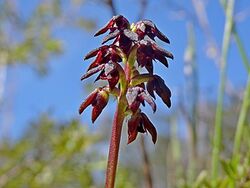Biology:Genoplesium vernale
| Spring midge orchid | |
|---|---|

| |
| Scientific classification | |
| Kingdom: | Plantae |
| Clade: | Tracheophytes |
| Clade: | Angiosperms |
| Clade: | Monocots |
| Order: | Asparagales |
| Family: | Orchidaceae |
| Subfamily: | Orchidoideae |
| Tribe: | Diurideae |
| Genus: | Genoplesium |
| Species: | G. vernale
|
| Binomial name | |
| Genoplesium vernale | |
| Synonyms[1] | |
| |
Genoplesium vernale, commonly known as the spring midge orchid or East Lynne midge orchid is a small terrestrial orchid which is endemic to a small area on the south coast of New South Wales. It has a single thin leaf and up to twenty five dark purplish-black flowers with tiny glandular hairs on the sepals and petals.
Description
Genoplesium vernale is a terrestrial, perennial, deciduous, herb with an underground tuber and a single thin, dark green leaf 100–180 mm (4–7 in) long and reddish at the base with the free part of the leaf 10–15 mm (0.4–0.6 in) long. Between ten and twenty five dark purplish-black flowers are crowded along a flowering stem 20–40 mm (0.8–2 in) long reaching to a height of 150–250 mm (6–10 in). The flowers lean downwards and are about 6 mm (0.2 in) long, 4.5 mm (0.2 in) wide and as with others in the genus, are inverted so that the labellum is above the column rather than below it. The dorsal sepal is broadly egg-shaped, 3.5 mm (0.1 in) long, 2.5 mm (0.1 in) wide with a sharply pointed tip and tiny glandular hairs on its edges. The lateral sepals are narrow oblong to lance-shaped, 4.5 mm (0.2 in) long, 1.5 mm (0.06 in) wide with a humped base, tiny glandular hairs on its edges and are more or less parallel to each other. The petals are lance-shaped to narrow egg-shaped, 3 mm (0.1 in) long, 1 mm (0.04 in) wide with a sharply pointed tip and tiny glandular hairs on the edges. The labellum is narrow oblong to elliptic in shape, about 3 mm (0.1 in) long, 1.5 mm (0.06 in) wide, thick and fleshy with tiny glandular hairs on its edges. There is a dark purple to brownish-black callus in the centre of the labellum and extending almost to its tip. Flowering occurs between September and December.[2][3]
Taxonomy and naming
Genoplesium vernale was first formally described in 2001 by David Jones and the description was published in The Orchadian.[4] In 2002, Jones and Mark Clements changed the name to Corunastylis vernalis.[5] The specific epithet (vernale) is a Latin word meaning "spring".[6]
Distribution and habitat
The spring midge orchid grows in shrubby forest between Jervis Bay and Mogo.[2][3]
Conservation
Genoplesium vernale is only known from a narrow belt of forest about 12 km (7 mi) wide. A survey conducted in 2000 found about 450 plants but the number is probably greater since not all suitable habitat has been surveyed. The main threats to the species are land clearing, forestry operations and inappropriate fire regimes. The species is listed as "Vulnerable" under the Commonwealth Government Environment Protection and Biodiversity Conservation Act 1999 (EPBC) Act and the New South Wales Threatened Species Conservation Act 1995.[7][8]
References
- ↑ "Genoplesium ostrinum". World Checklist of Selected Plant Families (WCSP). Royal Botanic Gardens, Kew. http://wcsp.science.kew.org/namedetail.do?name_id=246898.
- ↑ 2.0 2.1 Jones, David L. (2006). A complete guide to native orchids of Australia including the island territories. Frenchs Forest, N.S.W.: New Holland. p. 184. ISBN 1877069124.
- ↑ 3.0 3.1 "Genoplesium vernale". Royal Botanic Garden Sydney. http://plantnet.rbgsyd.nsw.gov.au/cgi-bin/NSWfl.pl?page=nswfl&lvl=sp&name=Genoplesium~vernale. Retrieved 10 February 2018.
- ↑ "Genoplesium vernale". APNI. https://id.biodiversity.org.au/instance/apni/594396. Retrieved 10 February 2018.
- ↑ "Corunastylis vernalis". APNI. https://id.biodiversity.org.au/instance/apni/581210. Retrieved 10 February 2018.
- ↑ "vernalis". Latin Dictionary and Grammar Resources. https://www.perseus.tufts.edu/hopper/text?doc=Perseus:text:1999.04.0059:entry=vernalis. Retrieved 10 February 2018.
- ↑ "East Lynne Midge Orchid - profile". New South Wales Government Office of Environment and Heritage. http://www.environment.nsw.gov.au/threatenedSpeciesApp/profile.aspx?id=10343. Retrieved 10 February 2018.
- ↑ "Conservation Advice Genoplesium vernale East Lynne midge-orchid". Australian Government Department of the Environment. http://www.environment.gov.au/biodiversity/threatened/species/pubs/68379-conservation-advice-16122016.pdf. Retrieved 10 February 2018.
External links
Wikidata ☰ Q15463618 entry
 |


